Bifold doors: A Comprehensive Guide
Bifold doors, sometimes called folding doors, have become increasingly popular in homes over the past decade.
As their name suggests, bifold doors fold in half and stack neatly when opened, making them space-saving and stylish additions to any room.
If you’re considering installing bifold doors in your home, this comprehensive guide covers everything you need to know, from costs and materials to types, pros and cons.
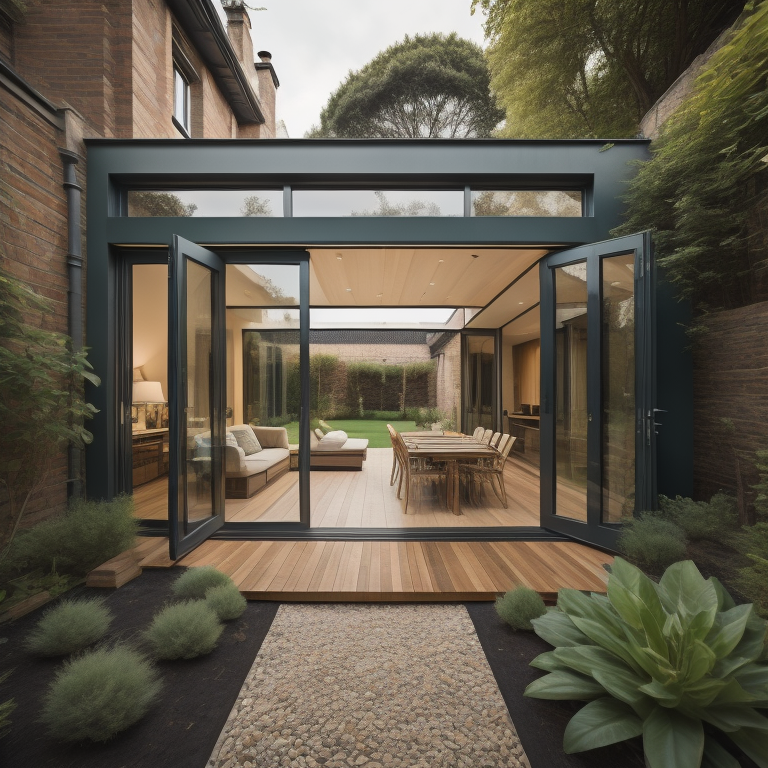
What are Bifold Doors?
Bifold doors consist of door panels that are connected by hinges that allow them to fold up accordion-style.
When open, the doors stack neatly to one or both sides of the doorway.
Typically, bifold doors are used for closets, pantries, laundry rooms and between rooms. They can be used in place of traditional swinging doors to save space or create an open-concept feel.
The number of door panels can vary, with two, four, six and eight panel configurations being most common.
Panels are usually of equal width and fit together when folded. The hinges, rollers and tracks allow the doors to slide and fold smoothly.
Bifold Door Materials
Bifold doors can be made from various materials, with some options for example:
- Wood: Natural woods like oak, maple and cherry add warmth and elegance. Wood can be painted or stained for customized looks.
- Vinyl: Affordable and low-maintenance, vinyl bifold doors have a modern, sleek appearance. Popular vinyl colours are white, beige and brown.
- Aluminium: Lightweight aluminium offers a contemporary look and is easy to maintain. Anodized aluminium comes in shades like champagne, bronze and black.
- Fiberglass: For a wood-like look with added durability, fiberglass bifold doors are a great choice. They require less maintenance than real wood.
- Wrought iron: Intricate hand-forged iron designs make a dramatic style statement. Wrought iron is durable and perfect for a Tuscan aesthetic.
Consider factors like your budget, room decor and desired functionality before choosing.
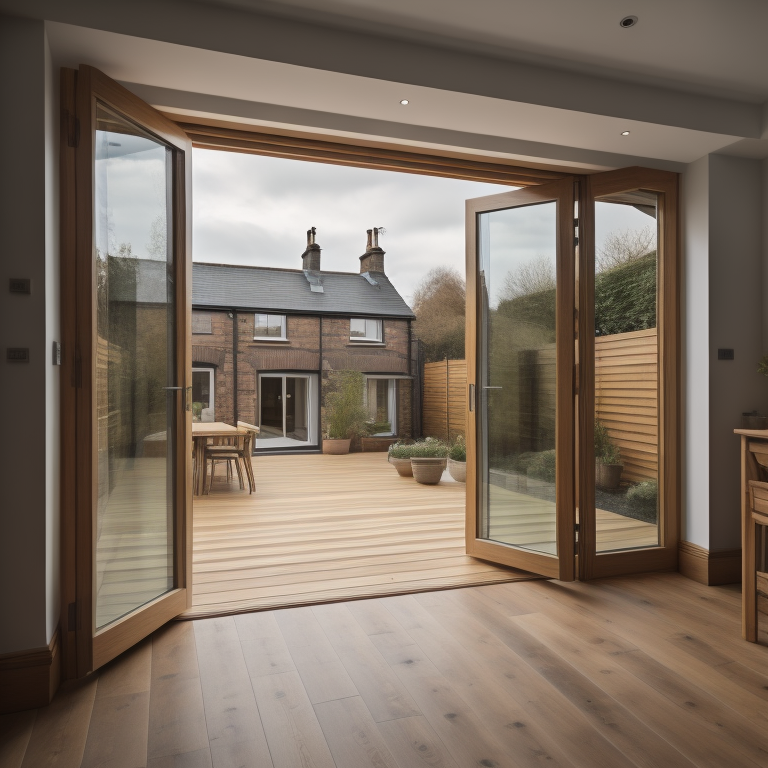
Types of Bifold Doors
There are a few main types to consider:
Interior Bifold doors
Interior bifold doors are suited for closets, pantries, laundry rooms and dividing rooms. They fold compactly out of the way and don’t require much clearance for operation. Interior bifold doors may be simple panel or mirror/glass styles.
Exterior Bifold Doors
Exterior bifold doors open up rooms to the outdoors. They’re ideal for patios, decks, porches and capturing panoramic views, whereas Exterior bifold doors need to be weatherproof and made of durable materials like aluminium or vinyl.
Room Dividers
They can make great room dividers. They can partition large spaces into multiple smaller areas or temporarily cordon off parts of an open floor plan. Tracks and hardware allow the doors to fold and stack out of sight.
Pocket Bifold Doors
Pocket bifold doors slide completely into recesses in the wall framing when opened. This saves even more space compared to regular bifold doors while maintaining an uninterrupted look. Installation is more complex though.
Bifold Door Sizes
One of the benefits of bifold doors is they come in a wide range of standard sizes to fit any space perfectly. So the most common interior door sizes are:
- 24-inch x 80-inch
- 28-inch x 80-inch
- 30-inch x 80-inch
- 32-inch x 80-inch
- 36-inch x 80-inch
Exterior bifold door sizes are often larger to span wider openings. Some standard widths are 4 feet, 6 feet, 8 feet, 10 feet and 12 feet. Heights usually range from 6.5 feet up to 8 feet.
Custom sizing is also an option if you have an unusually sized space.
When measuring for bifold doors, be sure to account for proper clearance. They need extra room to fold and stack on each side. Your contractor can help determine ideal bifold door sizes for your project.
Bifold Door Costs
On average, bifold doors cost £450 to £1,100 installed. Here’s a breakdown of what impacts the overall project cost:
- Door material: Vinyl is the most affordable at £110-£220 per door. Wood costs £220-£600 per door, while fiberglass and aluminium fall in the mid-range. Wrought iron is high-end at £500-£1,100 per door.
- Number of panels: More panels equals higher cost. For example, two-panel doors will be cheaper than eight-panel versions.
- Door size: Larger bifold doors naturally cost more than smaller sizes. Custom oversized doors add expense as well.
- Hardware: Pricier hardware with stainless steel, soft-close hinges and antimicrobial coatings obviously increases the total price.
- Installation: Complexity of install and contractor fees for labour will impact cost. Expect to pay £150-£450 for installation.
- Special features: Added details like clad frames, glass inserts or custom designs can raise the budget.
Bifold door costs ultimately come down to the materials used, special features and contractor rates in your area.
Material cost comparison
| Material | Size | Full installation cost |
|---|---|---|
| Vinyl | 24″ x 80″ | £800 – £1,000 |
| Vinyl | 36″ x 80″ | £900 – £1,200 |
| Wood | 24″ x 80″ | £1,000 – £1,400 |
| Wood | 36″ x 80″ | £1,200 – £1,800 |
| Fiberglass | 24″ x 80″ | £1,100 – £1,500 |
| Fiberglass | 36″ x 80″ | £1,300 – £1,900 |
| Aluminium | 24″ x 80″ | £1,000 – £1,400 |
| Aluminium | 36″ x 80″ | £1,200 – £1,800 |
| Wrought Iron | 24″ x 80″ | £1,500 – £2,000 |
| Wrought Iron | 36″ x 80″ | £1,800 – £2,500 |
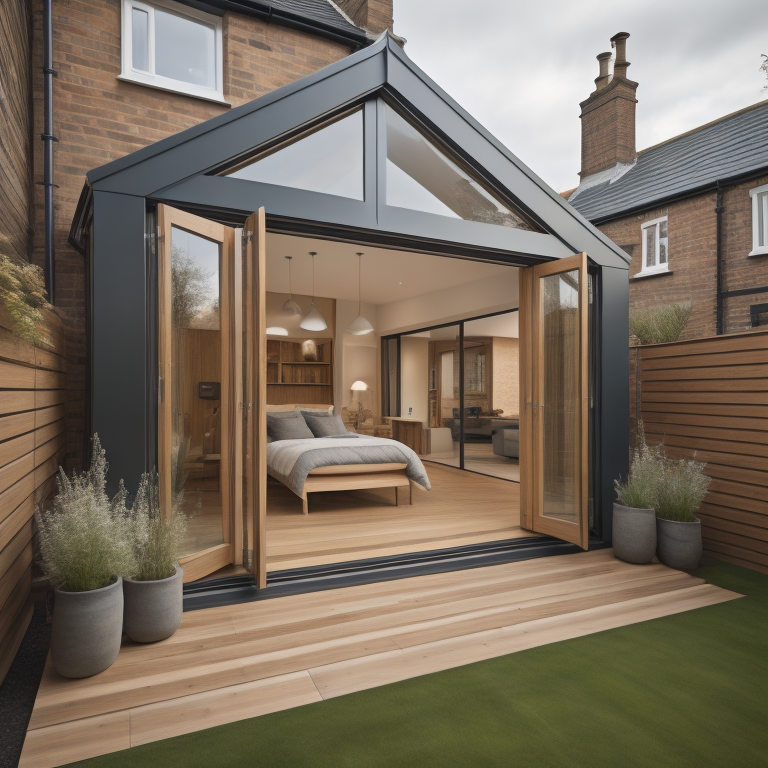
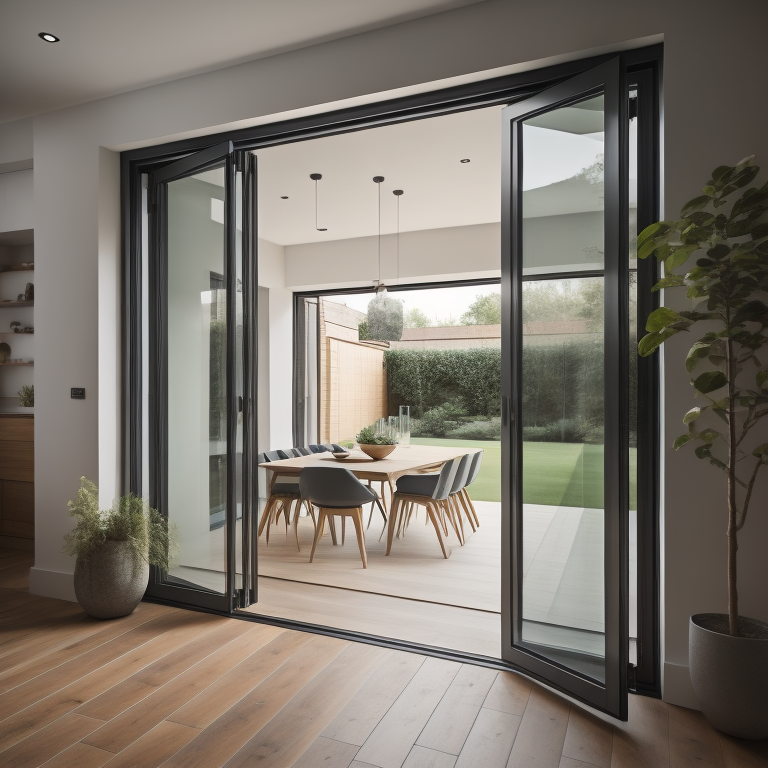
Pro’s for Bifold
Bifold doors offer many benefits.
Pros
- Space savers – Fold compactly and reduce doorway clearance needed
- Contemporary style – Sleek look for modern interiors
- Versatile – Use as room dividers, closets, patio doors and more
- Natural light – Glass panels and full openings allow light flow
- Open concept – Create airy, free-flowing spaces between rooms
- Customizable – Choose from many designs, materials, sizes and also hardware
Con’s for Bifold
There are however some Con’s to consider.
Cons
- Potential privacy issues – Some materials like vinyl have flex or gaps
- Not very soundproof – Hinges can transfer noise through folds
- Possible jamming – Debris in tracks or unaligned panels can obstruct movement
- Limited widths – Individual panels typically only 3 feet wide
- Higher cost – More expensive than hinged or sliding doors
- Complex installation – Precision required to hang tracks and panels
Finding an Experienced Bifold Door installer
Installing bifold doors is a complex process best left to qualified professionals. When hiring a bifold door installer, here are a few tips:
- Review online reviews and talk to past clients to verify quality of work.
- Look for expertise with the specific door materials you choose.
- Confirm the installerr is licensed, bonded and insured.
- Get at least three detailed estimates to compare pricing and services.
- Ask about warranty coverage – quality contractors will guarantee materials and labour.
- Check that they will acquire all necessary permits and arrange inspections.
First thing to remember is reputable bifold door companies have the expertise to handle measurements, custom sizing, tricky installations and adjust tracks for seamless operation.
Don’t cut corners on contractor selection to ensure top performance and safety.
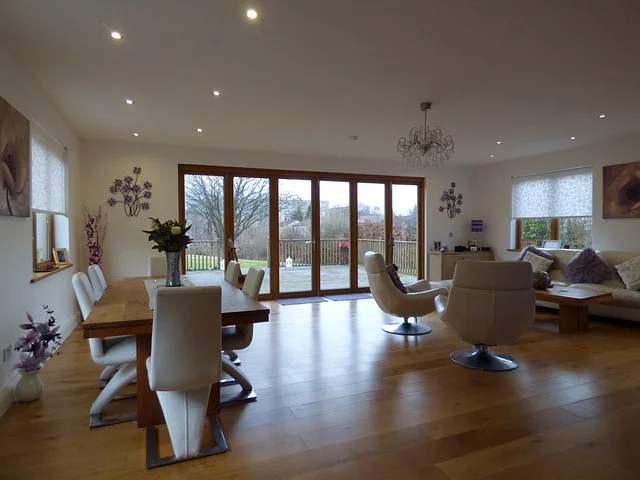
Maintaining Your Bifold Doors
With proper care and maintenance, bifold doors will provide many years of smooth operation and stylish good looks:
- Clean tracks regularly with a handheld vacuum and compressed air to remove debris and dust.
- Use a quality spray lubricant on hinges and rollers every 6-12 months. Check for squeaks or grinding.
- Inspect rollers and latches for signs of wear or damage. Replace immediately if found.
- Adjust tracks and tighten hardware as needed if doors become difficult to open or close.
- Refinish wood door panels with fresh seals or paint when scuffs and scratches accumulate.
- Check weatherstripping and exterior seals seasonally to maintain insulation and prevent leaks.
- Lastly use gentle cleaners and water only to clean doors, avoiding harsh chemicals.
In summary developing a regular bifold door maintenance routine will add longevity and ensure they continue functioning flawlessly for long-lasting enjoyment.
Has our guide helped you?
Bifold doors are a versatile choice that can enhance many spaces in your home when selected, installed and cared for properly.
Use this comprehensive guide to make informed decisions about bifold door costs, materials, styles, pros and cons, contractors, sizing and maintenance needs.
With the right information and professional installer, you’ll be able to enjoy seamless style and space savings with quality bifold doors for years to come.
If you want to take the next step and get quotes from local installers click the below button and request your free no obligation quotes!
Bifold door FAQ’s
Bi-fold doors are a type of door that consists of several panels that fold in on themselves to create an opening. They are typically used to connect indoor and outdoor spaces, such as a patio or garden.
Bi-fold doors can be made from a variety of materials, such as uPVC, aluminium, or timber. Each material has its own benefits, such as durability, energy efficiency, or aesthetic appeal.
Yes, bi-fold doors can be designed to be energy efficient, with features such as insulated glass and thermally broken frames.
Yes, bi-fold doors can be designed to be secure, with features such as multi-point locking systems and toughened glass.
